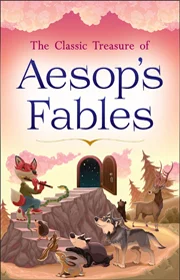
“Aesop’s Fables” is a collection of timeless tales attributed to the legendary ancient Greek storyteller Aesop. Featuring a cast of clever animals and anthropomorphic characters, each fable imparts a moral lesson or proverb. These short narratives explore fundamental aspects of human behavior, ethics, and wisdom, making them enduring and universally relevant. With simplicity and wit, Aesop’s Fables have captivated readers for centuries, offering valuable insights into the complexities of life through engaging storytelling and memorable lessons.
Read Fables of Aesop Flipbook:
Listen to Fables of Aesop Audiobook:
Title: “Aesop’s Fables”
Author: Aesop, a wise and clever figure believed to have lived around 620–564 BCE in ancient Greece.
Genre: Fables – short narratives featuring animals, plants, and inanimate objects, conveying moral lessons.
Format: “Aesop’s Fables” is a compilation of moralistic tales, typically featuring anthropomorphic animals, each with a moral lesson or proverb at the end.
Themes: Morality and ethics are central themes, with stories teaching virtues such as honesty, kindness, and wisdom.
Notable Fables:
“The Tortoise and the Hare”: Emphasizes the value of perseverance over speed.
“The Boy Who Cried Wolf”: Teaches the consequences of dishonesty.
“The Fox and the Grapes”: Illustrates the concept of sour grapes, discouraging envy.
Moral Lessons: Focused on imparting practical wisdom and life lessons, encouraging readers to reflect on their behavior.
Timeless Appeal: Aesop’s Fables continue to captivate readers of all ages, transcending cultural and generational boundaries.
Legacy: The fables have influenced literature, art, and popular culture worldwide, with their enduring impact on moral education.
Adaptations: Countless adaptations, translations, and retellings have emerged over the centuries, showcasing the universality of Aesop’s insights.
Illustrations: Many editions feature charming illustrations that bring the characters and lessons to life, making them accessible to children.
Educational Value: Widely used in educational settings to instill moral values and critical thinking skills in young readers.
Enduring Relevance: Aesop’s Fables remain a cherished literary treasure, demonstrating the enduring power of simple yet profound storytelling.